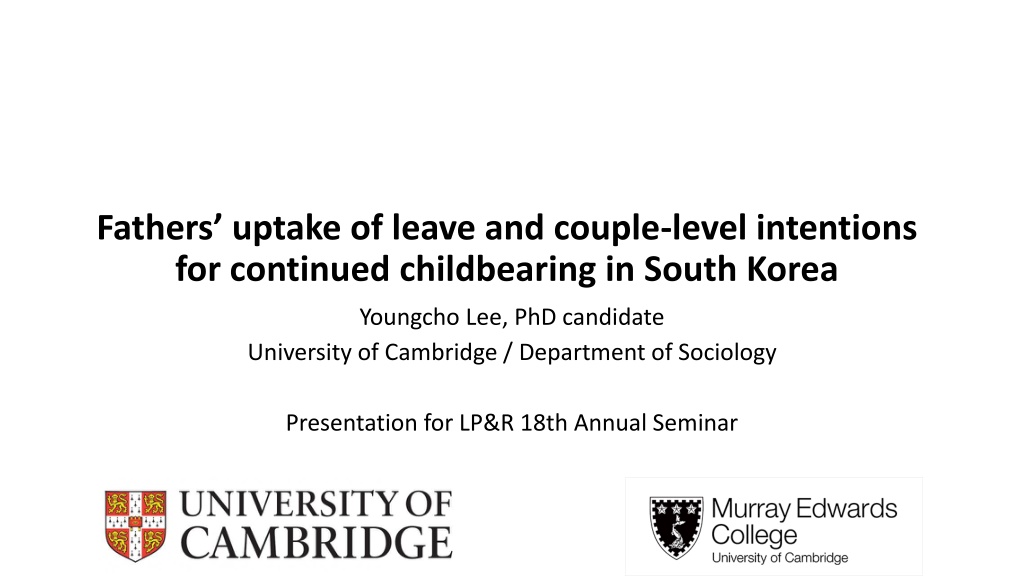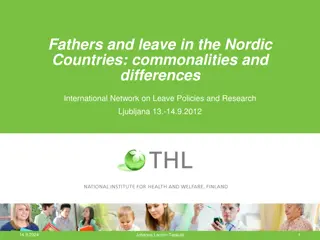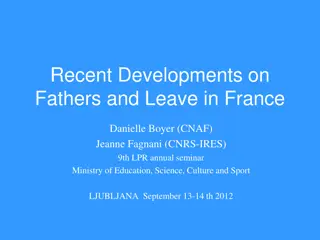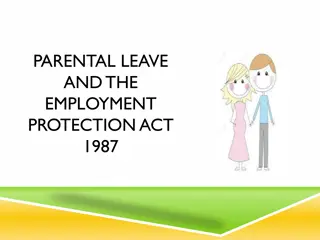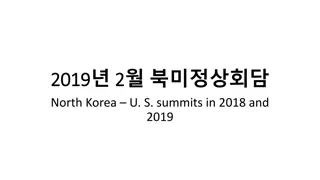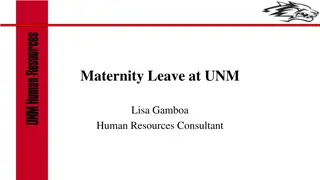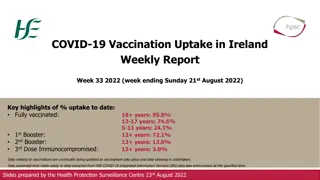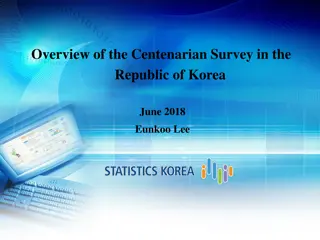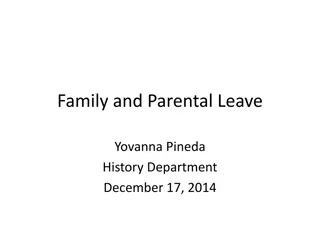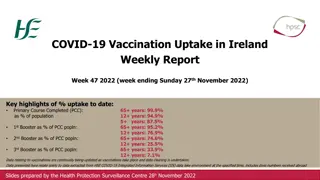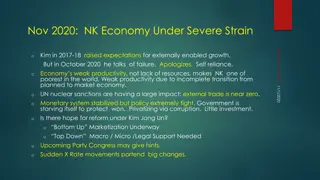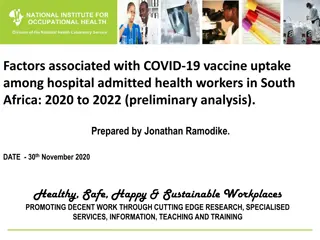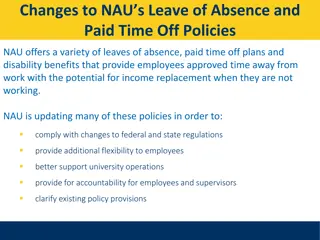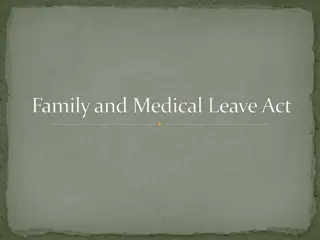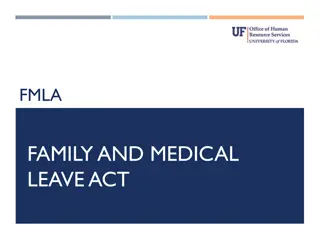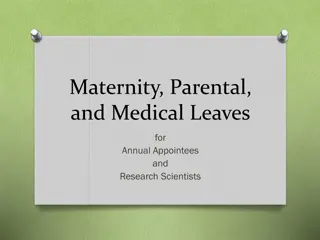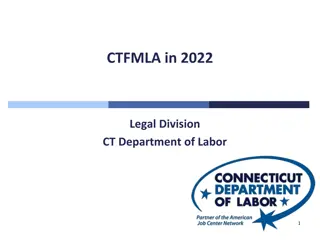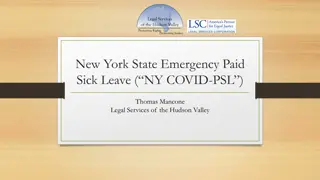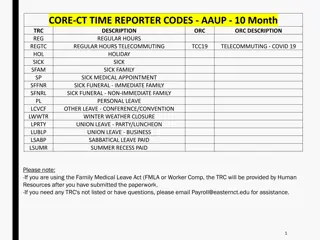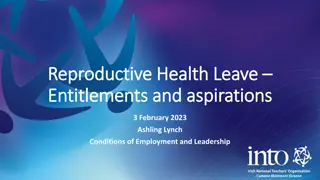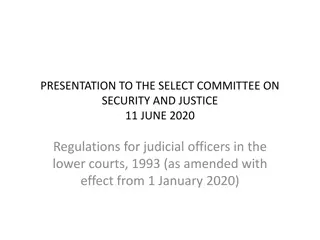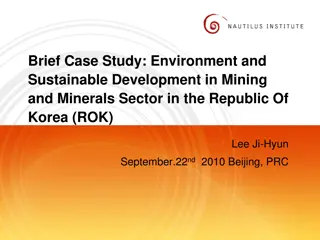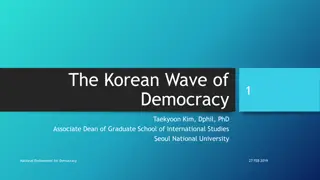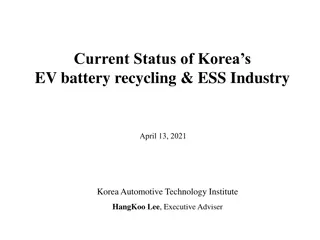Fathers' Uptake of Leave and Childbearing Intentions in South Korea
This presentation explores the correlation between fathers' uptake of leave and intentions for continued childbearing in South Korea, comparing findings from other countries. It discusses the impact of paid and unpaid work hours, gender role attitudes, and patterns of fathers' leave uptake in different OECD countries. The focus is on the unique South Korean context with low fertility rates, gendered division of labor, and parental leave policy. The introduction of "daddy months" in 2014 is highlighted as a significant step towards promoting father involvement in childcare.
Download Presentation

Please find below an Image/Link to download the presentation.
The content on the website is provided AS IS for your information and personal use only. It may not be sold, licensed, or shared on other websites without obtaining consent from the author. Download presentation by click this link. If you encounter any issues during the download, it is possible that the publisher has removed the file from their server.
E N D
Presentation Transcript
Fathers uptake of leave and couple-level intentions for continued childbearing in South Korea Youngcho Lee, PhD candidate University of Cambridge / Department of Sociology Presentation for LP&R 18th Annual Seminar
Background Positive association between fathers uptake of leave and second births in Sweden, Norway, and Iceland, but unclear for Hungary (Duvander and Andersson 2006; Duvander et al. 2010; Duvander et al. 2019; Ol h 2003) Findings mixed for third births, some find a weaker but positive association (Duvander and Andersson 2006; Duvander et al. 2010), others find a reversed association (Lappeg rd, 2010; Duvander et al., 2019) Duvander et al. (2020) finds that the introduction of father s leave quotas did not affect fertility in Norway and had a positive but temporary causal effect only on third-birth risks for lower-income couples in Sweden Context Selection
Paid work hours in select OECD countries (hours / annum) 2500 2000 1908 1767 1687 1644 1598 1577 1500 1424 1402 1369 1367 1332 1000 500 0 Germany UK Norway France Sweden Spain Japan Canada OECD average US Korea Paid work hours
Unpaid work in select OECD countries (minutes per day) 350 300 289.1 271.3 263.4 248.6 242.3 250 227.4 224.3 224 223.7 220.2 215 200 171 168.5 165.8 150.4 148.1 145.9 150 140.1 136.5 134.9 100 49 40.8 50 0 Germany UK Norway France Sweden Spain Japan Canada OECD average US Korea Men Women
Gender role attitudes across countries (ISSP, 2012) Men s job to earn money, women s job to look after home (% agree) How should women work when child is under school age (% full-time ) Country Sweden 5.86% 25.64% Norway 5.19% 32.44% Iceland 6.83% 33.62% South Korea 38.54% 9.7%
Pattern of fathers leave uptake Mean use (mothers) 82 days App. 210 days 180 days Payment rate 75.7% 94.2% 68.2% Country Uptake rate Mean use Sweden Norway Iceland Quebec (Canada) 88.3 % App. 90 % 86.0 % 79 days 47 days 91 days App. 80 % 49 days - 75.0% 119 days 410 days (13.5 months) Germany 40.4 % 65.0% (3.9 months) 207 days 310 days (10.2 months) South Korea 1.8 % 29.3% (6.8 months)
South Korean context The lowest fertility rate (TFR) in the world of 0.84 in 2020 One of the most imbalanced gendered division of unpaid labour in OECD One of the longest paid work hours in OECD South Korean parental leave policy: flexible and generous in terms of time but not income replacement Introduction of daddy months in 2014 fivefold increase in number of fathers uptake but still around 2% of all eligible fathers Longest leave in the world (6-7 months on average)
Background Gender revolution framework (Goldscheider, Bernhardt, and Lappeg rd s, 2015) & gender equity theories of fertility suggest that greater gender equality at home through men s increased involvement in unpaid labour will lead to an increase in birth rate (McDonald, 2000a; 2000b, 2006; 2013; see Raybould and Sear, 2021) How generalisable across context? (level of work-family imbalance, gender equality in division of unpaid labour) Men respond to increased gender equality in division of unpaid labour in which direction
Data and methods Mixed methods study design Web survey targeted at married fathers with preschool children, oversampling fathers with leave experience (N=1,042) IV: fathers leave experience 247 (23.70 percent) have taken leave in the past, 152 (14.59 percent) are currently on leave, 161 (15.45 percent) are planning to take first leave shortly, 482 (46.26 percent) have neither leave experience nor plan DV: Intended fertility: Do you and your wife have plans for another child? Yes / unsure / no 51 interviews with fathers with leave experience (21 in person, 30 virtual)
Data and methods Some limitations: Quantitative data not representative (caution required in generalising findings) & measures fertility intentions rather than outcomes Qualitative interviews only with fathers and not with mothers Both cross-sectional (unable to make causal arguments or track over time; bias from retrospective data) Strengths: Triangulate complementary sources of data and methods Quantitative data: allows for direct comparison between fathers who plan to take first leave & fathers who have taken leave (account, to an extent, for selection effect) Studying fertility intentions may offer different perspective (interim effect)
On leave 36.17 34.32 2.93 Have taken 37.20 35.49 3.90 Plan to No leave Total Father s mean age Wife s mean age Mean age of youngest Number of children (%) 35.78 33.39 2.52 37.10 34.79 3.54 36.78 34.67 3.38 One Two 54.61% 45.39% 11.84% 50.61% 49.39% 8.10% 75.78% 24.22% 16.77% 62.66% 37.34% 9.75% 60.65% 39.35% 10.75% Wife is pregnant (%) Father s leave length Short (~3 months) Moderate (4~11 months) Long (12 months~) 31.09% 39.08% 29.83% 81.78% 79.35% Father uni degree holder Wife uni degree holder Wife is currently 80.26% 82.24% 86.34% 80.12% 65.98% 67.63% 74.95% 74.47% Working 59.21% 19.08% 21.71% 575.00 338.82 152 (14.59%) 55.87% 16.19% 27.94% 576.92 350.20 247 (23.70%) 39.75% 41.61% 18.63% 570.19 347.83 161 (15.45%) 35.48% 19.50% 45.02% 509.96 366.18 482 (46.26%) 44.44% 22.07% 33.49% 544.63 355.57 1042 (100%) On leave from work Economically inactive Mean joint income Mean father income N
Employment Age (mean, range) 38 (27-42) Public sector 21 Age of youngest (mean, range) 3 (0-8) Large private company 5 Number of children Small/medium private company 13 One 19 Non-profit sector 8 Two 28 Freelance or self-employed 3 Three 4 Not in employment 1 Months of leave (mean, range) 13 (2.5-36) Division of paid work Number of leave Dual-earner couple 45 Once 46 Single-earner husband 5 Twice 4 Single-earner wife 1 Thrice 1 Education Solo or joint leave Secondary 1 Solo leave 45 Two-year college 4 Joint with wife 4 Four-year university 38 In-part joint 2 Graduate degree 8 Leave ongoing or finished Monthly household income Finished 32 Under 5,000,000 (app 3300) 16 On first leave 15 Over 5,000,000 (app 3300) 35 On second or third leave 4
Intention for another child by leave group Households with two children (n=410) Households with one child (n=632) 90 84.43 70 83.89 82.61 82.44 63.2 80 60 69.23 70 50.6 47.94 50 60 45.03 37.7 50 40 33.61 32.53 40 28.69 27.85 30 27.48 27.48 24.21 30 20 20 16.87 16.8 20.51 20 14.49 12.3 11.71 10.56 10.26 10 10 5.85 5.56 3.28 2.9 0 0 On leave Have taken Plan to No leave Total On leave Have taken Plan to No leave Total Yes No Unsure Yes No Unsure
Likelihood of intention for another child VARIABLES One child Yes Two children Yes Unsure Unsure Father s leave: (Baseline: plan to take leave) Currently on leave Have taken in the past No experience, no plan Observations Pseudo R-squared 0.84 0.67 0.96 0.48+ 0.57 1.03 0.07** 0.07*** 0.09*** 0.91* 0.90 0.84 630 0.11 407 0.14 Note: *** p<0.001, ** p<0.01, * p<0.05, + p<0.1 Model controlling for: age, education, and income of father and mother, age of the youngest child, whether mother is pregnant Baseline: no intention for another child
Main results from interviews Originally, we had thoughts about having a second child but I felt too exhausted after raising the child myself. Of course, having another (child) would have been nice Frankly, I think I did consider (a second child) when going on parental leave, but it being too demanding was why (I changed my mind). I didn t want to go through (childcare) again so much that I got vasectomy. (Q: What do you think will happen to fertility rates if all parents, both mothers and fathers, go on leave of one year each?) I think it (low fertility) will be aggravated. Because look, the negative consequences of having a child goes to women. If we balance some of that to this group (men), there will be an increase in men who feel negative (about having more children).
Additional contextual/complicating factors Lack of social support and individualised responsibilities for childcare Childcare is socially undervalued, both in terms of people s perceptions and the governments position. (childcare) is just expected to be taken care of through one person s sacrifice, that one person s labour being grinded in will somehow take care of things . Now families have become nuclearised so even in our couple s case, we have almost nobody who we can seek help from. So it is solely up to just the individual, that s why it s so difficult. Fluid, interactive, and unpredictable nature of childbirths After (having our first child), it was so exhausting So I told my friends and colleagues who were married but had no kids that they should have just one child I raised the child and it was too much work, so we thought we should have just one because it s too difficult. But we ended up having three.
Conclusion and implications Fathers taking leave seems to have an anti- rather than pro- natalist effect Resistance about embodying earner-carer lifestyle? Exceptional work-family conflict and lack of social support for childcare The relationship between fathers uptake of leave (or gender equality more generally) and fertility is context dependent, mediated by: Work-family balance Childcare support Norms about gender roles Limitations: generalisability / intentions vs outcomes / mother s view
Thank you! This doctoral research is generously funded by the Cambridge Trust & Murray Edwards College Scholarship Please feel free to get in touch with me for further comments, questions, and suggestions or if you would simply like to connect at: yl670@cam.ac.uk / @youngcho_lee
